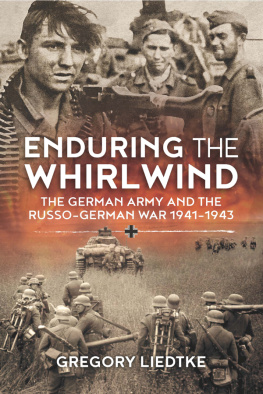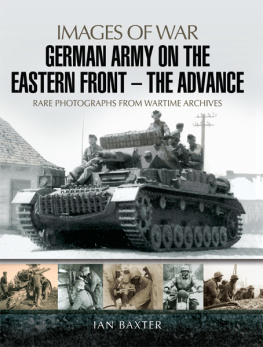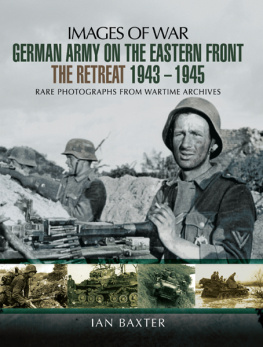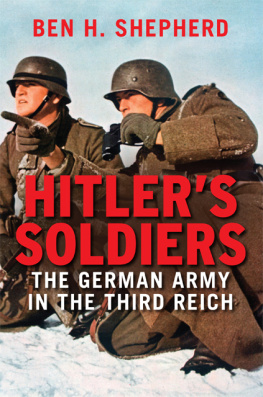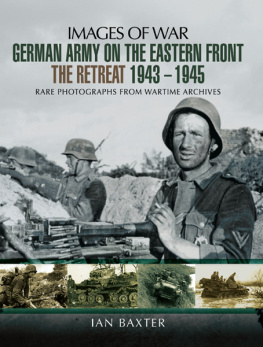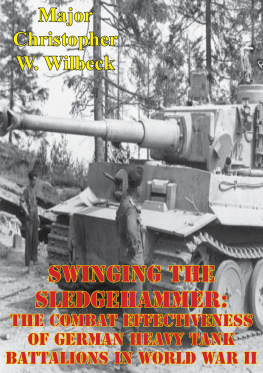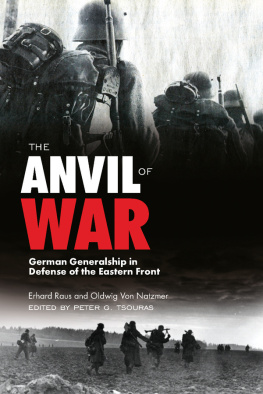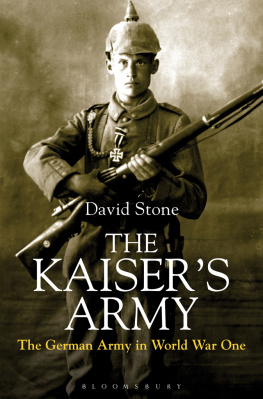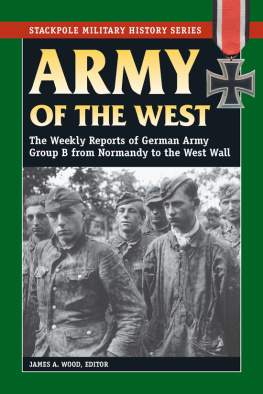
ENDURING THE WHIRLWIND
Enduring the Whirlwind
The German Army and the Russo-German War 1941-1943
Wolverhampton Military Studies No.21
Gregory Liedtke

Helion & Company Limited
26 Willow Road
Solihull
West Midlands
B91 1UE
England
Tel. 0121 705 3393
Fax 0121 711 4075
Email:
Website: www.helion.co.uk
Twitter: @helionbooks
Visit our blog http://blog.helion.co.uk/
Published by Helion & Company 2016
Designed and typeset by Mach 3 Solutions Ltd ( www.mach3solutions.co.uk )
Cover designed by Paul Hewitt, Battlefield Design ( www.battlefield-design.co.uk )
Text Gregory Liedtke 2016
Maps drawn by George Anderson Helion & Company Ltd 2016
Every reasonable effort has been made to trace copyright holders and to obtain their permission for the use of copyright material. The author and publisher apologize for any errors or omissions in this work, and would be grateful if notified of any corrections that should be incorporated in future reprints or editions of this book.
ISBN 978-1-910777-75-6
eISBN 978-1-911096-87-0
Mobi ISBN 978-1-911096-87-0
British Library Cataloguing-in-Publication Data.
A catalogue record for this book is available from the British Library.
All rights reserved. No part of this publication may be reproduced, stored in a retrieval system, or transmitted, in any form, or by any means, electronic, mechanical, photocopying, recording or otherwise, without the express written consent of Helion & Company Limited.
For details of other military history titles published by Helion & Company Limited contact the above address, or visit our website: http://www.helion.co.uk .
We always welcome receiving book proposals from prospective authors.
List of Maps
3.1 Operations in the Leningrad Region, July to November 1941.
3.2 The Slow German Advance on Leningrad, 12-30 September 1941.
3.3 Formation and Disposition of Soviet Armies, June to December 1941.
3.4 Heeresgruppe Mitte Closes in on Soviet Forces around Smolensk, 20 July 1941.
3.5 The Smolensk Pocket, 28 July 1941.
3.6 Heeresgruppe Mitte Holds the Line, 15 August 1941.
3.7 Situation in the Brody-Dubno Region, 28 June 1941.
4.1 The Winter Campaign, December 1941 to April 1942.
5.1 Operation Blue Stage Two: Operations in the Donets River Basin, 10-24 July 1942.
5.2 Operation Whirlwind and the Soviet Offensive around Rzhev, August 1942.
5.3 The German Advance upon Stalingrad and the Soviet Bridgeheads at Serafimovich and Kremenskoya, late August 1942.
5.4 The Extent of German Gains by 18 November 1942.
6.1 The Russo-German Front, 18 November 1942.
6.2 Operations along the Eastern Front, November 1942 to May 1943.
List of Tables
1.1 German Import and Domestic Production of Rubber and Iron Ore, 1932-1939 (Thousands of tons)
1.2 Air Force Expenditures of the Great Powers of Europe, 1933-1939. (Expenses/budget in equivalent US dollars)
1.3 European Aircraft Production and Proportion of Combat Aircraft, 1933-1939
1.4 German Armament Production, August to December 1939
1.5 Authorized Personnel Requirements of German Army Divisions, September 1939
1.6 Equipment Requirements of German Army Field Divisions based upon assigned TOE, 1 October 1939
1.7 Estimated German Field Army Equipment Requirements versus Existing Stock, 1 October 1939
1.8 Personnel Losses of German Divisions committed to the Polish Campaign, 1939
1.9 German Monthly Armaments Production, December 1939 to April 1940
1.10 Equipment in Stock with the German Army, 1 October 1939 and 1 May 1940
1.11 Equipment Requirements of German Army Field Divisions based upon assigned TOE, 1 May 1940
1.12 Divisions of the German Army by Type, 1 May 1940
1.13 German Field Army Equipment Requirements versus Existing Stock, 1 May 1940
1.14 Strength of German Panzer Divisions at the Outset of the French Campaign, 10 May 1940
1.15 German Armoured Strength and Losses, May-June 1940
1.16 Casualties Sustained by German Formations during the French Campaign, May-June 1940
2.1 Armoured Strength of German Panzer Divisions committed to Barbarossa, 22 June 1941
2.2 Armament Plant Capacity and Output for the German Army April 1941
2.3 German Army Weapons Stocks, May 1940 and June 1941.
2.4 Equipment Requirements of German Army Field Divisions based upon Assigned TOE, 22 June 1941
2.5 Estimated German Field Army Equipment Requirements versus Existing Stocks, 1 June 1941
2.6 Overall Strength of German Armour Assets and Commitment to Barbarossa, 22 June 1941
2.7 Strength and Operational Readiness of German Air Assets committed to Operation Barbarossa, 21 June 1941
3.1 Expansion of the Red Army 1938 to June 1941
3.2 German Armoured Strength during the Advance upon Leningrad, September 1941.
3.3 Second Panzer Group Personnel Losses, 22 June 4 July 1941
3.4 Losses Among the Divisions belonging to Heeresgruppe Mitte , 22 June to 10 August 1941
3.5 Armoured Status of Heeresgruppe Mitte , Late August/Early September 1941
3.6 Estimated Total Armoured Strength of Heeresgruppe Mitte for Operation Typhoon, 30 September 1941
3.7 Initial Personnel Strength and Combat Losses Sustained by 1. Panzergruppe as of 11 September 1941
3.8 Armoured Strength of 1. Panzergruppe , Early September 1941
3.9 Estimated Manpower Status of the 1. Panzerarmee , 1 November 1941
4.1 Ten-Day Divisional Losses Reported by 3. Panzergruppe , December 1941
4.2 Combat and Non-Combat Losses sustained by the 4. Armee , December 1941 and January 1942
4.3 German Army Equipment Losses on Ostfront , 22 June 1941 to 31 January 1942
4.4 Condition of 2. Panzerarmee , 15 December 1941
4.5 Comparison of the Strength of the Soviet Armed Forces, 22 June 1941 and 1 May 1942
4.6 Strength and Deployment of the Soviet Armed Forces, 1 May 1942
4.7 Comparison of Axis Formations deployed on Ostfront (including Finland), June 1941 and June 1942
4.8 Monthly Raw Material Requirements of the Wehrmacht versus Actual Allocation, First Quarter of 1942 (tons)
4.9 Monthly Production of Army Equipment, 1941-1942
4.10 German Armaments Production versus Total Losses on All Fronts, 1 June 1941 to 1 July 1942
4.11 Estimated Material Requirements of the German Army, 1 July 1942
4.12 Estimated German Tank Strength on the Ostfront , 1 January 1942
4.13 Overall Development of German Armoured Strength by 1 July 1942
4.14 German Armour Requirements for New Formations, Replacements Dispatched to North Africa, and Allotments to Axis Allies, 1 July 1941 to 30 June 1942
4.15 Authorized versus Actual Strength of the Panzer Divisions with Heeresgruppe Sd , 1 July 1942
4.16 Estimated German Armour Distribution and Surplus, 1 July 1942
4.17 Personnel Shortages among Divisions with Heeresgruppe Nord , 1 April 1942
4.18 Personnel Shortages within the Divisions of Heeresgruppe Nord , 1 April and 1 July 1942
4.19 Estimated Personnel Changes within the Wehrmacht , June 1941 to July 1942
5.1 Personnel Losses amongst German Divisions committed to the First Stage of Operation Blue until 10 July 1942
5.2 Tank Strength of 4. Panzerarmee in the Voronezh Sector, 28 June to 5 July 1942
5.3 German Armoured Strengths, Late July 1942
Next page
